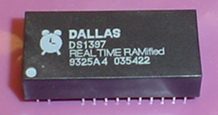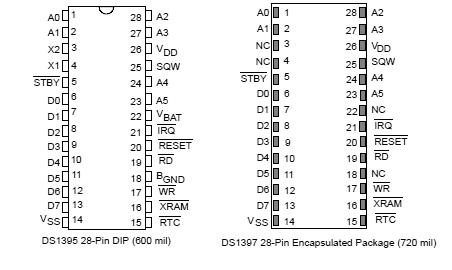I moved on to rework the Dallas DS1387 module that was used in some PS/2s. Well, don't tell the PS/2s, but I also have some EISA systems from Compaq. Specifically, I have three Deskpro/M series systems, two 486DX-33 units and one 386DX-33 model. None of them have the special places that my PS/2s do, although I am partial to the 386/33 unit and have gone a little bit out of my way to fix it up.
Evidently Dallas Semiconductor thought it appropriate to produce a clock/calendar module for EISA computers. That module is the DS1397. It too has no modern replacement. When yours dies, it's dead, or so we're told to believe by Dallas-Maxim Integrated Products. Here's a picture of the beast.

Little does it know that we are about to OPERATE!
What you need to do is very similar to the DS1287 and 1387 modules. You need to find the positive and negative battery connections on the module and expose them. And after you've done that, you need to find the place where the terminals live. On the DS1397, this would be pins 22 (battery + ) and 18 (battery - ) These are labeled in the datasheet as no-connect but as you can see in the image below, the DS1397 shares the same trait of being nothing more than an IC packaged with a battery and clock crystal with its closely related siblings.


(The battery - and battery + pins are on the top row closest to the camera.)
So let's get whittling! For the sake of this demonstration, I pulled the lonely Deskpro 486-33/M out from under my bed. Should you question whether or not that is worth mentioning, I will take this opportunity to mention that my bed is a rickety, dangerous contraption in which the Deskpro may have been performing some role pertaining to structural reinforcement...on the side of the bed that is against two walls. I figured that it would be an ideal candidate for a Dallas module donation and retrofit because A) I certainly haven't been using it, B) it wouldn't really hurt anything if I broke the module while opening it and C) this machine hasn't been powered on since sometime in 2003 or 2004. All of these were very good reasons to justify taking the bed apart, opening the computer and retrieving the module.
I am certain that everyone present at the time (around 11:30 at night) enjoyed the sounds of my dismantling nearly every part of my bed.
Oh, and the module should certainly be discharged at this point. Surely the batteries inside it have come to the end of their useful lifetime.

Oh. I always end up surprising myself at least once during most of my projects. From now on I will be referring to this DS1397 module as Lazarus.
I was able to take the voltage reading above once I'd started to slice into the module. My original plan was to cut the leads, yet it seems that time has stopped for this particular module. I really can't believe that after all these years (16, or 1993-2009, to be exact) that this module seems to have a very strong battery in it! Dallas only rates these things to last about ten years in the total absence of power. I know this machine hasn't been used a lot since 1999 (when it was given to me).
For now I've left this module alone. Although the terminals are exposed, the internal battery is still connected. I'll probably check back in on it in a few more years and see how it is doing then. My Deskpro/M 386 complains of a low battery, but it hasn't quit yet, so I'll leave it alone for now as well. However, if you'd happen to have a need to re-energize your DS1397 module, this does go to show that the procedure is nearly the same as the DS1x87 modules, with only a minor difference in the numbering of the pins you need to find and expose.
Addendum: Here in mid-2017, the DS1397 module in my EISA Deskpro 386-33 is still working. So too is the one in the complete 486 system. It'll lose the time and date if left to sit for a while, but still maintains the NVRAM contents. Since I've turned the machine on maybe three times since writing this page in 2009 and it was stored in completely unconditioned space for much of that time, that's pretty impressive. (I have since misplaced the module shown on this page, which came from a mostly stripped Deskpro 486. If I ever find it again, and I doubt that I will, I'll check in on it and report back.)